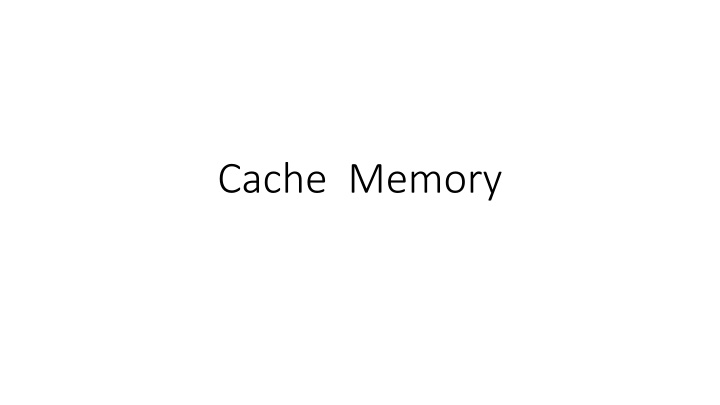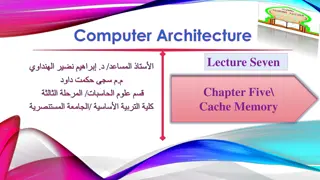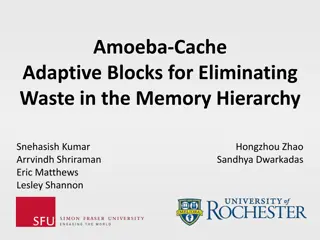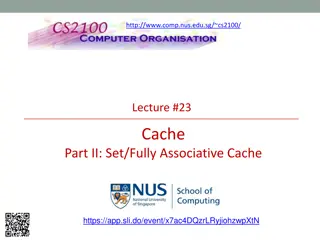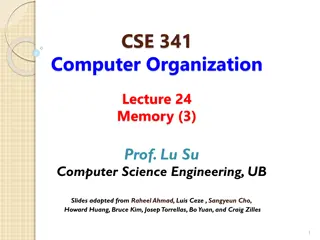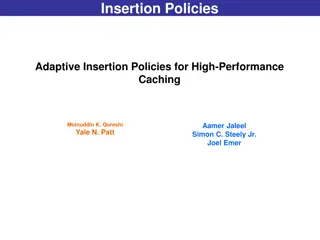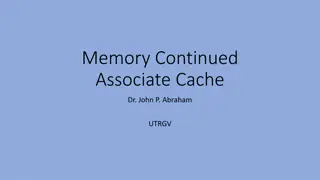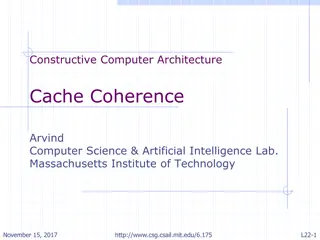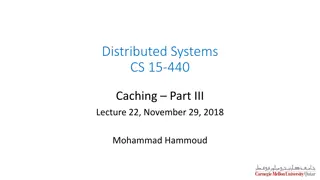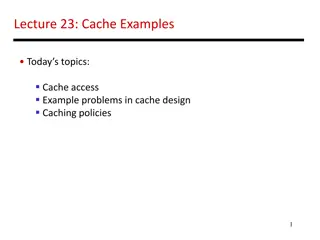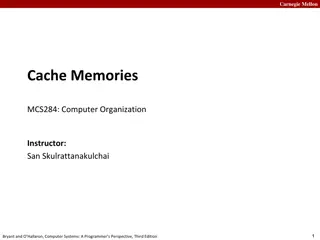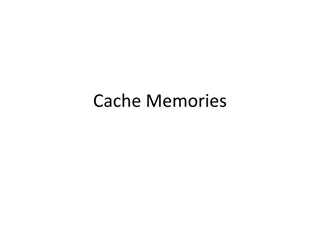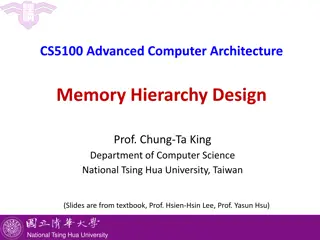Cache Memory Operations
Cache memory plays a crucial role in reducing the average memory access time for CPUs by storing frequently accessed data. It acts as a bridge between the CPU and main memory, improving overall performance. The operation of cache memory, hit ratio calculations, and different mapping processes are explained in detail. Learn how cache memory enhances system efficiency and speeds up program execution.
Download Presentation

Please find below an Image/Link to download the presentation.
The content on the website is provided AS IS for your information and personal use only. It may not be sold, licensed, or shared on other websites without obtaining consent from the author.If you encounter any issues during the download, it is possible that the publisher has removed the file from their server.
You are allowed to download the files provided on this website for personal or commercial use, subject to the condition that they are used lawfully. All files are the property of their respective owners.
The content on the website is provided AS IS for your information and personal use only. It may not be sold, licensed, or shared on other websites without obtaining consent from the author.
E N D
Presentation Transcript
Introduction: When a program instruction is executed, the CPU repeatedly refers to the set of instructions in the memory. Every time a subroutine is called, its instructions are fetched from the memory. Over a short interval of time, the address generated by a program refers to few localized areas of memory repeatedly. That is ,only some portion of memory will be accessed repeatedly at a particular time while the remaining memory in the main memory is accessed less frequently.
It takes more time for the CPU to access the main memory each and every time . If the active portions of the program and data are placed in a fast small memory, the average memory access time can be reduced, which reduces the total execution time of the program. Such a fast small is called Cache Memory . Cache memory is placed between CPU and main memory. Cache memory access time is less than that of main memory by a factor 5 to 10. Cache is the fastest components in the memory hierarchy.
Basic Operation of Cache memory: When the CPU needs to access some memory, first the cache is examined. If the word to be accessed is found in the cache memory, then it is read from the fast memory. If the word is not found in the cache memory, then it is read from the main memory. A block of words just accessed in the main memory is automatically transferred to cache memory. Cache memory contains a replica or the copy of the main memory.
When the CPU refers to a memory and finds that word in the cache, it is called hit . When the word is not found in the cache and it is present in the main memory, then it is counted as miss . The ratio of no.of hits to the no.of total CPU references to memory(hit+ misses) is called as hit ratio . The performance of the cache memory is frequently measured in terms of hit ratio. Hit ratios are found to be more than 0.9. Hit ratio = (hit)/(hit+miss).
Mapping process: The transformation of data from main memory to cache memory is called mapping process . There are three types of mapping procedures in the organization of cache memory: 1. Associative mapping 2. Direct mapping 3. Set-associative mapping
Associative Mapping: The fastest and most flexible cache organization uses an associative memory. The associative cache memory stores both the address and the content i.e., data of the memory word. CPU address(15 bits) Argument register 0 1 0 0 0 3 4 5 0 Address Data 0 2 7 7 7 6 7 1 0 2 2 3 4 5 1 2 3 4 Cache memory
The diagram shows three words presently stored in the cache. The address value is of 15 bits which is shown in 5 digit octal number. Its corresponding 12-bit word is show in 4-digit octal number. A CPU address of 15-bits is stored in the argument register and the associative memory is searched for the matching address . If the address is found, it is hit and the word is read into the CPU,if the address is not found, then it is miss and the word is read from the main memory and the address data pair is then transferred to the cache memory. If the cache is full, then the words in the cache are to be displaced to make room for new words.
Direct Mapping: The drawback of Associative mapping is it is more expensive as it has an added logic associated with each cell. To overcome this drawback ,we move to Direct Mapping. In direct mapping we use the random access memory. To organize direct mapping, the CPU address of 15 bits is divided into two fields: 1. the nine least significant bits constitute the index field. 2. the remaining six bits constitute the tag field.
Addressing relationships between main and cahe memories: 6 bits 9 bits Tag Index 00 000 32k x 12 512 x 12 000 Main memory Cache memory Octal address Octal address Address = 15 bits Data = 12 bits Address = 9 bits Data = 12 bits 777 77 777
Set-Associative Mapping: The drawback of direct mapping is two words is two words with same index but with different tag values cannot reside in the cache memory for the same time. Set-Associative mapping is an improvement of direct mapping in which each word of cache can store two or more words of memory under the same index address. Each data word is stored together with its tag and the number of tag- data items in word of cache is said to form a set.
Writing into cache: There are two methods: 1.Write-through method: memory write operation and the cache memory is also updated in parallel if it contains that word in the specific address. It has an advantage that main memory always contains the same data as that of the cache memory. 1. Write-through method. 2.Write-back method. In this method , main memory is updated with every
2.Write-Back method: The location where the memory is updated is marked by a flag So that when the word is removed from the cache , it can be added to main memory easily. The advantage of this method is we can update the memory several times easily during the program execution and when the word id removed from the cache the accurate copy is re-written into the main memory. In this method only the cache memory is updated.
Cache Initialization: The cache memory is initialized when the power is supplied to the computer or when the main memory is loaded with a complete set of programs from the auxiliary memory. After initialization , ideally the cache has to be empty , but it instead it contains some invalid data. Therefore, a valid bit is included with each word in cache to check whether the word contains valid data or not. Firstly , all the valid bits are set to 0 when the cache is initialized. When a new word is loaded from main memory to cache , the valid bit is set to 1. 1 indicates valid data and 0 indicates invalid data.
